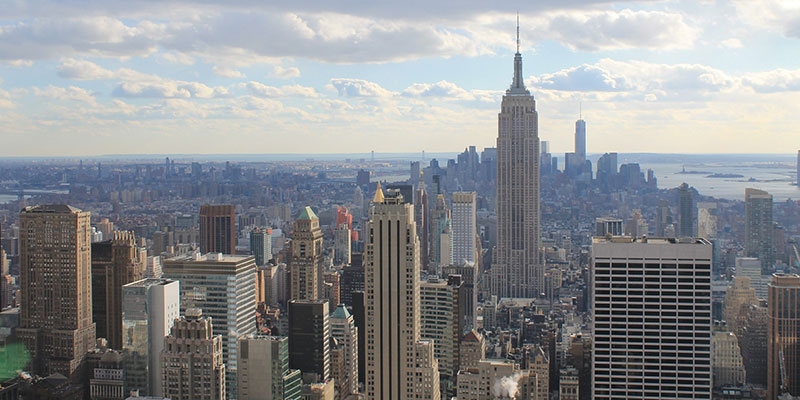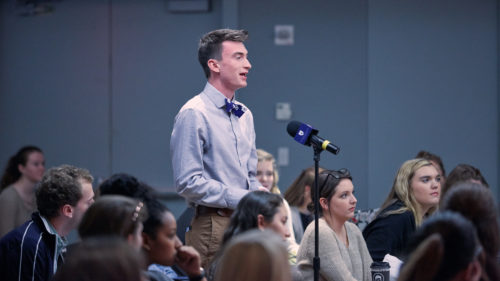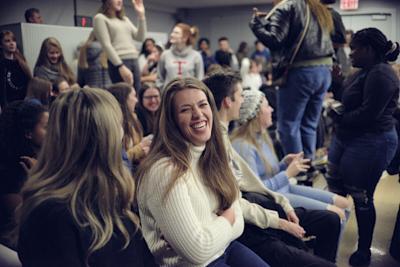January 2017 History Spotlight | Bygone Glamour at the Empire State Building
This month, we examine the history of the spot of ground on which King’s reopened in New York City—the site of the Empire State Building.

When The King’s College reopened in New York City in 1999, it did so on some of the most expensive soil in the world[1], justifiably turning heads among those who pay attention to things like Christian higher education, New York City real estate, and the supposedly secular culture of Manhattan. This month, we examine the history of the spot of ground on which King’s reopened—the site of the Empire State Building.
All of Manhattan was originally Lenape Indian hunting ground[2], and what is now some of the world’s most coveted real estate was famously sold to Dutch settlers for 60 guilders in May 1626[3]. During the colonial years, life on Manhattan clustered at its southern end, where King’s is located now. Around the time of American independence, the land where the Empire State Building would be built was a small meadow belonging to a farmer named John Thompson. Thompson had bought his 20-acre farm in 1799 for 482 British pounds. He sold it in 1825 for ten thousand dollars to one Charles Lawton, who made a handsome profit on it himself when one of the John Jacob Astors[4] bought the property two years later. William Backhouse Astor, Sr. then bought a half-interest, but because New York City did not yet reach that far north, the Astors simply held the lot as an investment property and did not live there. However, as the city grew, it could only go north, and Fifth Avenue soon became its most fashionable thoroughfare. In 1859, William’s brother John Jacob Astor, Jr., built a mansion at Fifth Avenue and 33rd Street. William built immediately to the north a few years later. Their two houses became the most important social destination in the city for wealthy New Yorkers—that is, for those who made the list. William’s wife, Caroline Webster Schermerhorn, had a famous 400-person list of New York’s most elite names who were invited to her annual ball. The length of the list was supposedly determined by the capacity of her ballroom, and Caroline ruled New York’s upper-crust social scene for several decades until her health began to fail in 1906.
The property moved on to its next use well before that, however. John Jacob, Jr., had a son named William, who, intending to get the better of his aunt Caroline in an ongoing feud, demolished the original Astor mansion in 1893 and began building the Waldorf Hotel. The Waldorf, designed by Henry Janeway Hardenbergh in a German Renaissance style and named for the ancestral hometown of the original John Jacob Astor, stood 13 stories tall and had 450 guest rooms. Its presence was not well received at first, but a benefit concert for St. Mary’s Hospital for Children, which was well regarded by the social elite, turned the first impression around. The hotel earned a whopping $4.5 million in its first year, and its Empire Room gained recognition as one of the best restaurants in the city.[5]
It was not only the prospect of living next to a hotel that drove The Mrs. Astor to leave her house at age 64. The neighborhood was becoming increasingly commercial, and most high society families had already moved north to the borders of Central Park. In 1894, The New York Times reported that another “huge hotel” was coming to the northern corner of the block at Fifth Avenue and 34th Street[6]. It would be called the Astoria Hotel, after the town founded by John Jacob Astor in Oregon.
The Astoria opened in 1897, designed by the same architect in the same style, though with different details—three stories taller than the original Waldorf, with 100 more guest rooms and ten more public rooms. Its Astor Dining Room reproduced that of the mansion that had preceded it. In at least an outward display of family unity, the owners of the two hotels decided to join them via a connection called Peacock Alley. The provisions governing the consolidation did contain a clause that allowed the connecting corridors to be bricked up if necessary; however, the joint hotel stood as a proud symbol of the Astor family’s wealth and success. Prior to the Waldorf’s construction, ladies typically did not enter hotels for social reasons, even with escorts; but the Waldorf-Astoria, under the management of Philadelphia hotelier George Boldt and his innovative wife Louise, redefined the idea of the hotel as a social hot-spot. It was a major destination for foreign dignitaries, home to its own orchestra, and a place where women could be admitted with or without an escort as they wished, simply to have tea.[7]
By the 1920s, retail establishments had flooded the area, and the hotel faced both larger taxes on its increasingly valuable property and competition from newer establishments such as the Knickerbocker and the Savoy-Plaza. While it never lost its status, it became a burden to its owners, who sold it in 1928 to the Bethlehem Engineering Corporation, led by John Jacob Raskob—a developer who dreamed of building a beautiful skyscraper.
Raskob and his associates hired the head architects of Shreve, Lamb, and Harmon to design the building, and paid attention to public relations concerns from the beginning. They worked with Democratic politician and New York State Governor Al Smith to champion their project, and as the Empire State Building took shape in both the public imagination and the New York City skyline, the site that had been a social hub for international dignitaries and New York’s leading lights took on a new, more popular celebrity.
Perhaps today it seems that tall, dramatic office buildings were the “manifest destiny” of New York City. After all, on such a small land mass, where is there to go but up? But at the time, the Empire State Building was anything but a given. It was ambitious enough to conceive of in the first place—the tallest building in the world—and the Great Depression struck during its planning phase. One can hardly imagine a developer today pursuing a monumental construction project under such conditions. But the brains behind the Empire State Building were interested in more than just an investment.
It was the period between the two world wars. Veterans of the Great War were writing harrowing stories of disillusionment with man’s quest to perfect the world and human society, making public the shocking cataclysm of death they had survived. World War I changed their vision of the world forever. But the clouds of horror and doubt that blanketed Europe did not so noticeably darken the hope for human progress in America. The United States had lost relatively little blood in Europe and busied itself with believing in the future—a future in which nations would work together for peace, alcohol addiction and its attendant social ills would be eradicated, civilians would travel the skies by dirigible, and even the Kingdom of God itself might be brought closer to earth by the wise and willing efforts of citizens concerned for their fellow men.[8] It was a future for which monuments deserved to be made.
Despite the Depression, the Empire State Building was completed in less than fourteen months. (For comparison, it took eighteen months to renovate the lobby in 2008.) Its design was architecturally innovative with its use of setbacks, which kept the building from blocking too much light from the street; its distinctive aesthetics made it immediately iconic; and even its construction techniques were new and interesting. Its spire was a later idea from Al Smith, intended as a docking station for dirigibles. It was not only the world’s tallest building, but the first to surpass 100 stories. The Empire State Building achieved instant fame as a symbol of New York’s hustle and ambition.
After Raskob’s death, the building passed through the hands of a series of companies and investors. The Empire State Realty Trust took the building public in 2013 with an initial public offering of $929.5 million. King’s resided there from 1998 to 2012. How did the Empire State Building, of all conspicuous and unlikely places, come to serve as the site for the College’s resurrection?
The King’s College, as we know, closed in 1994 by order of the New York State Commissioner for Higher Education. However, it was allowed to keep its legal charter—a highly unusual action taken at the discretion of the Deputy Commissioner, one Dr. Nolan, which essentially let the College continue to exist. Nolan expressed to Friedhelm Radandt, then president of King’s, that he believed New York State needed a Christian college such as King’s and was praying for King’s to reopen.[9]
After the College closed, a few staff stayed on in a volunteer capacity, including Radandt and his wife Elizabeth. One day, a $100,000 check arrived on Radandt’s desk, along with a message that it was not to be used to settle any debts, but to explore the idea of reopening the College in New York City. Taking this as a divine direction, Radandt formed an exploratory committee, which met in the Lincoln Building across from Grand Central Terminal. One of its members was a man named Don Kim, a commercial realtor who oversaw rentals at the Empire State Building. At one meeting, Kim told the committee, “I have discovered space designated for education in the Empire State Building, and I’m holding it for The King’s College.”
At this time, King’s still owned both the Briarcliff Manor campus, thanks to protracted delays from town that prevented the College from selling it to the Irish cultural organization Tara Circle, as well as a separate tract of land in Tuxedo that it had purchased for the purpose of relocating. Lehman Brothers, which held the Briarcliff mortgage, saw that the sale was going to fall through and King’s wasn’t going to be able to pay its debts, and so was moving toward foreclosure—which would have wiped out the College’s fragile finances and eviscerated any ability to recover. There looked to be no way out of this situation, and hope was slim indeed.
Thus, Radandt recounts that when the exploratory committee heard Kim’s news, “We were all dumbfounded, and at the same time enormously intrigued. We all knew that The King’s College was in no position to sign a lease agreement for space in the Empire State Building; there simply were no finances to do so. Yet could it be that God not only wanted us to think in terms of New York City as the place where we were to locate King’s, but was also letting us know that He had already set aside teaching space in that landmark building? If so, then God would also make level the path that could lead to fulfilling that dream. And God did.”
Radandt received a phone call one day from Stan Oakes of Campus Crusade for Christ—“a person I had never heard of”—thanks to a connection by Briarcliff professor Udo Middelmann, who later came back to teach in Manhattan. Over several visits, Radandt explained the College’s troubles to Oakes, showed him the space in the Empire State Building, and told him about the unlikely attempt to reopen. The day before the Lehman foreclosure was scheduled to move forward, Campus Crusade wired money to the College that gave it footing on which to apply for bankruptcy status and reorganize. After the bankruptcy court judge approved the reorganization plans, The King’s College came out of bankruptcy as a subsidiary of Campus Crusade for Christ, which provided the necessary funds for the College to sign its original lease with the Empire State Building on June 9, 1998.[10]
King’s leased additional space in 2000, 2004, and 2005, leading to a total campus size of 42,000 square feet. The College occupied portions of the Lower Lobby level two floors below the street, the Concourse level immediately above it, and the fifteenth floor for executive and faculty offices. As glamorous as the College’s address was, life below decks presented some challenges—most memorably the sewage overflows in an outer corridor, caused by periodic backups in the building’s aging plumbing system. Students lived in two apartment buildings nearby—the Herald Towers and the Vogue. The Herald Towers had once been the McAlpin Hotel: one of the city’s most expensive establishments charging $5 per night, as the story goes. The Vogue was a 1980s construction notable for its balconies (overlooking the Macy’s Thanksgiving parade route), its irascible doorman, its one-time mailman Jimmy McMillan (now a perennial mayoral candidate in New York City and founder of the political party “The Rent Is Too Damn High”), and a 2014 prostitution bust connected with that year’s Super Bowl. Later, when city regulations lowered the number of non-family tenants allowed to share apartments in old buildings without sprinkler systems, the College rented additional dorm-style apartments in a building much farther away on Ludlow Street—an almost universally-hated situation.
Back at the Empire State Building, part of the fifteenth floor space was sub-leased from another tenant, whose lease expired during the 2008-2009 school year. This, and the College’s growth, led the school to relocate faculty offices across 33rd Street on the eighth floor of 330 Fifth Avenue—almost 12,000 square feet of space in a shorter, newer, graceful building that boasted beautiful views up Fifth Avenue from its hallways and two classrooms with the novel amenity of sunlight.
During the College’s time in the Empire State Building, the Malkin family came into control of the corporation that had owned the Empire State Building since 1961.
Anthony (Tony) Malkin, who succeeded to leadership of the corporation after his father Peter retired, spearheaded a project in 2009 to retrofit the building with energy-efficient equipment that would reduce its energy consumption by 40 percent.[11] In 2010, King’s was beginning to enjoy broader name recognition across America and higher enrollment numbers, and accordingly began negotiating with the Empire State Building’s management for more space. That lease agreement would have increased the College’s footprint there to 59,000 square feet, and in early 2012 King’s was within two weeks of signing it. The owners, however, suddenly made it known that they were preparing to take their company public, and that in their opinion, the presence of a college would reduce the building’s value. They no longer wanted King’s as a tenant, and the College had less than ten months to move.
Of course, God had not brought King’s through the fires of near-foreclosure to let eviction shut its doors. The Malkins’ decision stung and certainly caused a significant degree of stress, but it did no lasting damage. Even in the suddenness and timing of their decision, the Lord’s mercies were in evidence: there were no students around when, one week after fall move-in, a disgruntled employee from a local business opened fire on the street corner outside the Starbucks at 34th Street and Fifth Avenue. Three months earlier, that Starbucks was a popular hub for students, staff, and casual meetings; but when the disturbance occurred, students had no reason to be at the Empire State Building and were, at the closest, safe in the Herald Towers. In the end, despite the Empire State Building’s iconic status and everyone’s gratitude for its role in heightening the drama of the College’s miraculous reopening, King’s moved almost without a backward glance. As we’ll see next month with the close of our site history series, the Lord provided anew.
[1] In consultation with Dr. David Tubbs, associate professor of politics at The King’s College, it was thought for some time during the writing of this article that the soil bearing the distinction of “World’s Most Expensive” was to be found among the great wine estates of France, specifically in Burgundy. As far as *soil* goes, that is likely to be true–certainly Burgundian vineyards are the most valuable wine-producing lands in the world, and it’s hard to imagine another form of agriculture that is either so prestigious or so famously tied to intimate specificities of geography and climate. New York City does claim a higher price per square foot than the world’s agricultural (or viticultural) lands, but several European capitals, along with Hong Kong, Beirut, and Singapore, beat New York’s price per square foot by significant margins.
[2] Readers who have been paying very close attention may remember that the Lenape have appeared in this series before, as the earliest known residents of what is now northern Delaware, where King’s had its second campus. (See “Lexington: An American Story.”)
[3] PBS THIRTEEN, “Dutch New York”: historical compilation commemorating the 400th anniversary of Henry Hudson’s voyage to New York, 2009. “Interactive Document: The Purchase of Manhattan Island, 1626.” http://www.thirteen.org/dutchny/interactives/manhattan-island/. Accessed January 11, 2017.
[4] It is extremely difficult to determine the accurate details of several transactions in this story that took place within the Astor family tree. Internet research yields circuitous and conflicting reports of who bought and built and was named what—names were often repeated in the Astor family, and not always along the same branch (e.g., John Jacob Astor III was the nephew, not the son, of John Jacob Astor, Jr.). Therefore, I have chosen to stick with research conducted from books, even though this research was conducted in late 2006 and the books belong to a public library in Ohio. Those works were The Landmark History of the American People: From Plymouth to Appomattox, by Daniel J. Boorstin; The Empire State Building, by Theodore James, Jr.; and The Architecture of New York City by Donald M. Reynolds. —ES
[5] “Waldorf-Astoria (New York, 1893)” Wikipedia. https://en.wikipedia.org/wiki/Waldorf–Astoria_(New_York,_1893) Accessed January 11, 2017.
[6] Tom Miller, “The Lost John Jacob Astor Mansion—840 Fifth Avenue.” May 19, 2014. Daytonian in Manhattan—blog. http://daytoninmanhattan.blogspot.com/2014/05/the-lost-john-jacob-astor-mansion-840.html. Accessed January 11, 2017.
[7] “Waldorf-Astoria (New York, 1893)” Wikipedia.
[8] This political and theological optimism about human effort played no small part in motivating Percy Crawford to tell the world in as many ways as he could that man is saved from his own sin and the mess it makes of the world only by the redeeming action of God in Jesus Christ, through the faith God Himself calls to life in us through the Holy Spirit. Percy’s son Dan recounts this link in detail in the biography A Thirst for Souls.
[9] This story and the details on how King’s came to the Empire State Building that follow were recounted by Dr. Friedhelm Radandt, third president of The King’s College, in his Founders’ Day address given in the City Room at The King’s College, April 18, 2016. The video of his remarks is published on The King’s College website.
[10] This date and following details about square footage in and ownership of the Empire State Building were provided via email correspondence by Frank Torino, Vice President of Finance at The King’s College. January 18-19, 2017.
[11] Anthony E. Malkin, “Four Reasons Why the Empire State Building Retrofit Model Works.” Clinton Foundation, 2014. https://www.clintonfoundation.org/blog/2014/08/12/four-reasons-why-empire-state-building-retrofit-model-works Accessed January 19, 2017.





